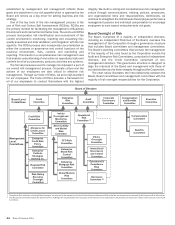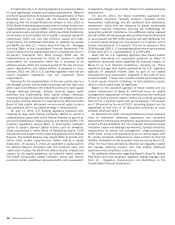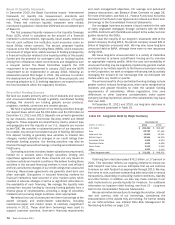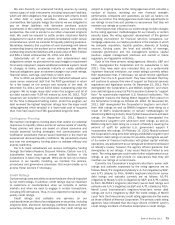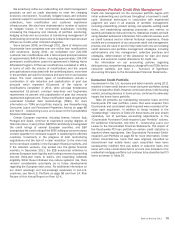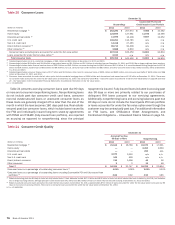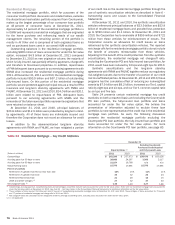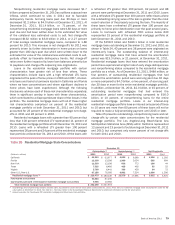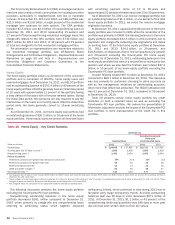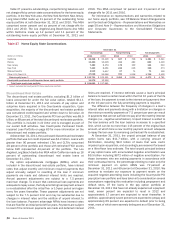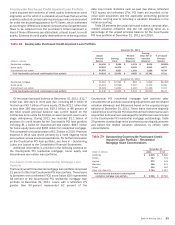Bank of America 2011 Annual Report Download - page 76
Download and view the complete annual report
Please find page 76 of the 2011 Bank of America annual report below. You can navigate through the pages in the report by either clicking on the pages listed below, or by using the keyword search tool below to find specific information within the annual report.74 Bank of America 2011
A further reduction in certain of our credit ratings or the ratings
of certain asset-backed securitizations may have a material
adverse effect on our liquidity, potential loss of access to credit
markets, the related cost of funds, our businesses and on certain
trading revenues, particularly in those businesses where
counterparty creditworthiness is critical. In addition, under the
terms of certain OTC derivative contracts and other trading
agreements, the counterparties to those agreements may require
us to provide additional collateral, or to terminate these contracts
or agreements, which could cause us to sustain losses and/or
adversely impact our liquidity. If the short-term credit ratings of
our parent company, bank or broker/dealer subsidiaries were
downgraded by one or more levels, the potential loss of access to
short-term funding sources such as repo financing, and the effect
on our incremental cost of funds could be material.
At December 31, 2011, if the rating agencies had downgraded
their long-term senior debt ratings for the Corporation or certain
subsidiaries by one incremental notch, the amount of additional
collateral contractually required by derivative contracts and other
trading agreements would have been approximately $1.6 billion
comprised of $1.2 billion for BANA and approximately $375 million
for Merrill Lynch and certain of its subsidiaries. If the agencies
had downgraded their long-term senior debt ratings for these
entities by a second incremental notch, approximately $1.1 billion
in additional collateral comprised of $871 million for BANA and
$269 million for Merrill Lynch and certain of its subsidiaries, would
have been required.
Also, if the rating agencies had downgraded their long-term
senior debt ratings for the Corporation or certain subsidiaries by
one incremental notch, the derivative liability that would be subject
to unilateral termination by counterparties as of December 31,
2011 was $2.9 billion, against which $2.7 billion of collateral had
been posted. If the rating agencies had downgraded their long-
term senior debt ratings for the Corporation or certain subsidiaries
a second incremental notch, the derivative liability that would be
subject to unilateral termination by counterparties as of December
31, 2011 was an incremental $5.6 billion, against which $5.4
billion of collateral had been posted.
While certain potential impacts are contractual and
quantifiable, the full scope of consequences of a credit ratings
downgrade to a financial institution are inherently uncertain, as
they depend upon numerous dynamic, complex and inter-related
factors and assumptions, including whether any downgrade of a
firm’s long-term credit ratings precipitates downgrades to its short-
term credit ratings, and assumptions about the potential behaviors
of various customers, investors and counterparties.
For information regarding the additional collateral and
termination payments that could be required in connection with
certain OTC derivative contracts and other trading agreements as
a result of such a credit ratings downgrade, see Note 4 – Derivatives
to the Consolidated Financial Statements and Item 1A. Risk
Factors of this Annual Report on Form 10-K.
During the third quarter of 2011, Moody’s and S&P placed the
sovereign rating of the United States on review for possible
downgrade due to the possibility of a default on the government’s
debt obligations because of a failure to increase the debt limit.
On August 2, 2011, Moody’s affirmed its Aaa rating and revised
its outlook to negative. On August 5, 2011, S&P downgraded the
long-term sovereign credit rating of the United States to AA+, and
affirmed the short-term sovereign credit rating; the outlook is
negative. On November 28, 2011, Fitch affirmed its AAA long-term
rating of the United States, but changed the outlook from stable
to negative. On the same day, Fitch affirmed its F1+ short-term
rating of the U.S. All three rating agencies have indicated that they
will continue to assess fiscal projections and consolidation
measures, as well as the medium-term economic outlook for the
United States.
Credit Risk Management
Credit quality continued to improve during 2011. Continued
economic stability and our proactive credit risk management
initiatives positively impacted the credit portfolio as charge-offs
and delinquencies continued to improve across most portfolios
and risk ratings improved in the commercial portfolios. However,
global and national economic uncertainty, home price declines and
regulatory reform continued to weigh on the credit portfolios
through December 31, 2011. For more information, see Executive
Summary – 2011 Economic and Business Environment on page
21.
Credit risk is the risk of loss arising from the inability or failure
of a borrower or counterparty to meet its obligations. Credit risk
can also arise from operational failures that result in an erroneous
advance, commitment or investment of funds. We define the credit
exposure to a borrower or counterparty as the loss potential arising
from all product classifications including loans and leases, deposit
overdrafts, derivatives, assets held-for-sale and unfunded lending
commitments which include loan commitments, letters of credit
and financial guarantees. Derivative positions are recorded at fair
value and assets held-for-sale are recorded at either fair value or
the lower of cost or fair value. Certain loans and unfunded
commitments are accounted for under the fair value option. Credit
risk for these categories of assets is not accounted for as part of
the allowance for credit losses but as part of the fair value
adjustments recorded in earnings. For derivative positions, our
credit risk is measured as the net cost in the event the
counterparties with contracts in which we are in a gain position
fail to perform under the terms of those contracts. We use the
current mark-to-market value to represent credit exposure without
giving consideration to future mark-to-market changes. The credit
risk amounts take into consideration the effects of legally
enforceable master netting agreements and cash collateral. Our
consumer and commercial credit extension and review procedures
take into account funded and unfunded credit exposures. For
additional information on derivative and credit extension
commitments, see Note 4 – Derivatives and Note 14 –
Commitments and Contingencies to the Consolidated Financial
Statements.
We manage credit risk based on the risk profile of the borrower
or counterparty, repayment sources, the nature of underlying
collateral, and other support given current events, conditions and
expectations. We classify our portfolios as either consumer or
commercial and monitor credit risk in each as discussed below.


